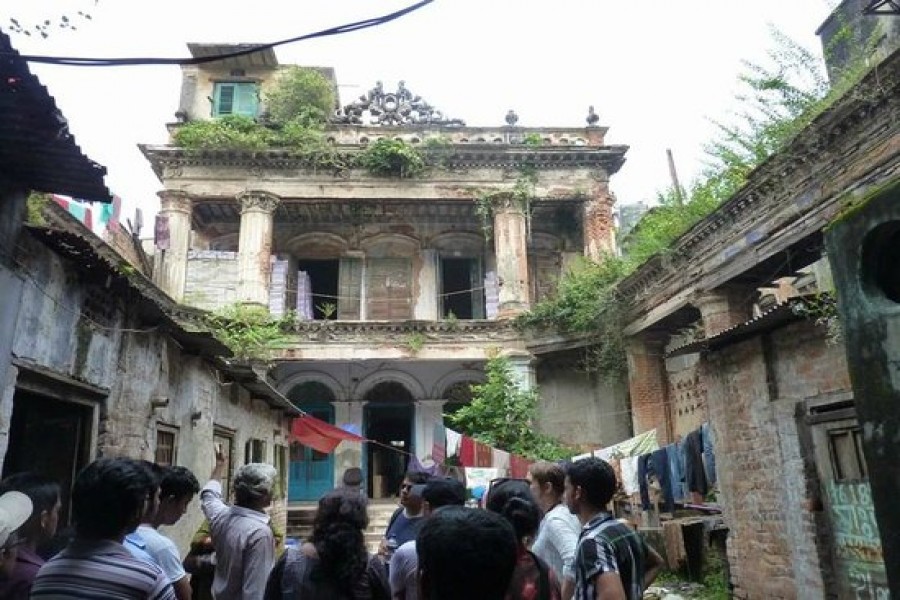The old part of Dhaka city, the old town in common parlance, is no doubt a much neglected location of today's greater Dhaka. The neglect, many will say, has heaped up over decades due mainly to the difficulties caused by the numerous narrow and derelict lanes and alleys, congested housing and commercial centres, shops and markets, even factories making a crammed, chock-a-block habitat seemingly unbending to any change for the better. Although town planners from home and abroad have for long been attaching importance to the four hundred year old cityscape for its unique historic distinction as well as its location on the bank of the Buriganga, hardly has there been any worthwhile move to ease living of a million residents -- the country's authentic urbanites.
Lately, it is heartening to know that plans are afoot with the assistance of the World Bank (WB) to help improve liveability of three large neighbourhoods of Old Dhaka. The WB will provide Bangladesh with $100.5 million in credit to undertake works aimed at enhancing public spaces and improving urban services in Lalbagh, Kamrangir Char, Sutrapur-Nayabazar-Gulistan under the Dhaka South City Corporation (DSCC). The project, dubbed Dhaka City Neighbourhood Upgrading Project, is expected to help upgrade public spaces such as parks, playgrounds, waterfronts, streets, footpaths and transform public buildings such as community centres into multipurpose facilities to serve communities, said a WB statement. It also aims to pilot interventions for safe mobility and traffic management and incorporate environment-friendly features and energy efficient design principles and materials in all interventions that it will support.
The need for these and a host of other development works calls for a well thought-out plan not just to improve civic amenities for the local residents but more importantly to ward off the ever-looming threats of blaze, building collapse, factory accidents, and last but not least, extreme pollution. The frightening fire incidents in the recent past that killed many people have set the alarm bell ringing for even more catastrophic events.
Needles to say, the task is challenging given the very setting and makeup of Old Dhaka. Still, there is no room for staying away, and it is here that utmost attention is required to redesign things, as far as possible, for the sake of a million inhabitants.
Since the issue of redeveloping Old Dhaka has finally come up, thanks to the WB assisted project, the concerned authorities should team up to further reinforce the works and also initiate other projects in the same direction. Although common perception of redevelopment suggests a massive structural change, experts are of the opinion that a good deal can be done without interfering with the present structure of old Dhaka. Eminent architect and vice president of the Bangladesh Poribesh Andolon (BAPA), Mubasshar Hussain is of the view that Old Dhaka needs a change from within whereby civic facilities can be considerably improved and heritage sites - mostly buildings and parks - can also be restored and renovated. As regards improving road conditions, he said in a recent interview with a local daily that while widening of roads is very important, movement of traffic and pedestrians can be facilitated by enforcement of a set of fresh rules. "With proper management", he said, "the conditions of the roads in Old Dhaka can be improved significantly. The narrow roads can be made one-way. Or, we can enforce some restrictions on movement of vehicles on them. The roads that are too narrow can be made off limits to cars and other modes of transport by building gates at both ends of the roads, allowing only rickshaws to move through." It may be mentioned that with proper management many cities in the world, even those in the developed world, are able to facilitate civic amenities including movement of traffic in some of their old and congested locations. Athens and Rome, to mention the two most prominent cities, are cases in point.
Setting up water hydrants in the roads of Old Dhaka is a priority job, according to Mr. Hussain. Absence of water source was found to be the main problem in combating the deadly fire incidents in Nimtali years back and Chakbazar in March this year. Fire fighters could not do their work properly because of insufficient water sources. In this regard, he said, "If there were water hydrants, scarcity of water would never be an issue. However, water hydrants will not serve any purpose unless the fire brigade buys special pumps which will be connected to the big vehicles. These pumps can be unlocked from the vehicles and dragged to the site of fire. Such pumps were used in the small towns of the country in the past."
Old Dhaka is so prone to fire disasters that last year it saw at least one fire incident a day on an average. Fire service data show at least 468 fire incidents struck the old town's Lalbagh, Hazaribagh, Sadarghat and Siddique Bazar, where more than 500 chemical warehouses and factories operate illegally. The decision on relocation of the chemical and plastic warehouses and factories in a separate area must be implemented to save Old Dhaka from recurring fire incidents.
There are indeed plenty of areas to work on. Town planners and architects are the right persons to identify the areas and suggest ways and means to accomplish the works. It is high time relevant agencies, including the city corporation, utilised their expertise and knowledge in the belated endeavour.


